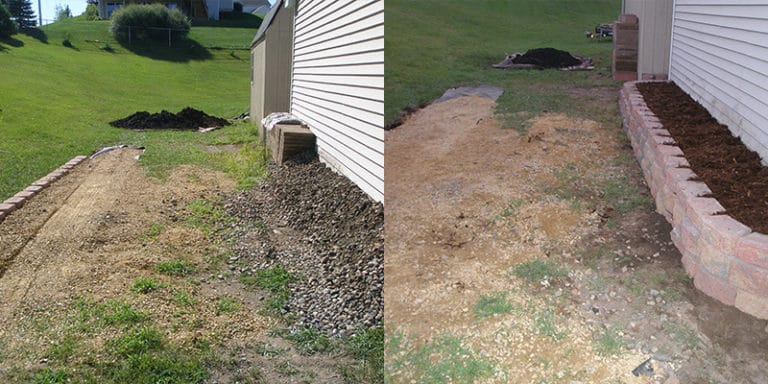Table of Contents
Your yard is more than just outdoor space—it’s an extension of your home’s comfort, safety, and value. But if you’re noticing constant soil erosion, water pooling, cracked pavement, or sloped areas you can’t use, your landscape might need more than routine maintenance. A retaining wall could be the answer. Beyond holding soil in place, retaining walls improve drainage, prevent costly structural issues, and unlock the potential of your outdoor space. Here’s how to tell if your yard could benefit from one.

Signs Your Yard Could Benefit from a Retaining Wall
1. Soil Erosion is Taking Over
Rain and wind can strip away soil on sloped properties, leaving bare patches, exposed roots, or muddy runoff after every storm. This not only damages plants but can also lead to slope instability. A retaining wall acts as a barrier that locks soil in place, preventing it from washing away and keeping your landscape healthy and intact.
2. Your Yard Slopes Too Steeply to Use
Sloped backyards often waste valuable space that could be a garden, seating area, or play zone. By installing a retaining wall, you can level sections of the yard and create terraced platforms. These flat areas instantly add functionality and allow for features like patios, fire pits, or raised vegetable beds.
3. Your Foundation is at Risk
One of the most serious red flags is when soil and water start pressing against your home. Over time, this “hydrostatic pressure” can cause basement leaks, cracks in the foundation, or even bowing walls. A properly engineered retaining wall reduces this pressure and redirects water away from your home, saving thousands in potential repair costs.
4. Pavement or Hardscapes Are Shifting
Driveways, walkways, and patios are especially vulnerable if the soil beneath them is unstable. You may notice cracks, uneven surfaces, or sections that are sinking. A retaining wall stabilizes the ground and prevents further shifting, ensuring your outdoor structures remain safe and durable.
5. Drainage Problems Are Causing Standing Water
Soggy lawns and puddles that linger for days can signal poor drainage. Not only is standing water unsightly, but it also attracts mosquitoes, damages turf, and can seep toward your foundation. Retaining walls can be built with integrated drainage systems to channel water away, keeping your yard dry and usable. For more detailed tips on managing water and preventing drainage issues around your home, check out our guide on 8 Ways to Improve Drainage Around Your House.
6. You Want to Upgrade Your Landscape Design
Even if your yard doesn’t have urgent structural issues, a retaining wall can add style and dimension. Materials like natural stone, brick, or decorative concrete bring depth and character, turning flat yards into layered landscapes with visual appeal. They can also double as seating walls, raised garden beds, or borders for outdoor living areas.
Beyond retaining walls, adding stone features can further transform your yard. If you’re planning a DIY project, check out our DIY Landscape Rock Installation: A Step-by-Step Guide for practical tips to create a polished, low-maintenance design.

Benefits at a Glance
| Benefit | What It Means for Your Yard |
|---|---|
| Erosion Control | Stops soil, mulch, and plants from washing away. |
| Drainage Improvement | Directs water runoff safely away from foundations and low spots. |
| Foundation Protection | Relieves pressure on basement walls and reduces risk of cracks or leaks. |
| Maximized Space | Transforms sloped areas into usable terraces for gardens, patios, or play zones. |
| Hardscape Stability | Prevents driveways, walkways, and patios from sinking or cracking. |
| Low Maintenance | Durable, long-lasting structures with minimal upkeep. |
| Enhanced Curb Appeal | Adds architectural interest, texture, and beauty to landscapes. |
| Increased Home Value | Functional, attractive yards appeal to buyers and raise property value. |
Conclusion
If your yard struggles with erosion, drainage, wasted slope, or foundation pressure, a retaining wall can provide lasting solutions while adding curb appeal. By stabilizing the soil, protecting your home, and creating usable outdoor spaces, retaining walls turn challenges into opportunities for beautiful, functional design. Looking for more landscaping inspiration? Check out our blog on 7 Reasons Why Homeowners Should Install Landscape Rock to see how rock features can complement retaining walls and bring even more value to your outdoor space. Consulting with a landscaping professional will ensure your wall is not only attractive but also structurally sound for years to come. For more detailed information and tailored advice, visit our page on Retaining Wall. For support on your next retaining wall project, please feel free to reach out through our contact form, and our team will be happy to help.



